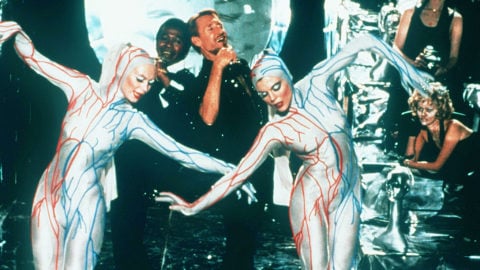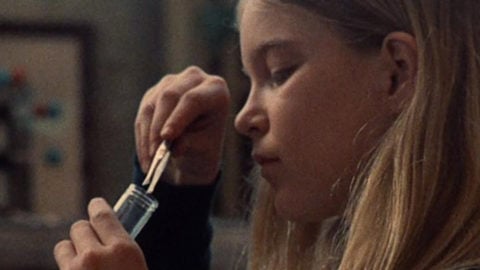Queer & Now & Then: 1968
In this biweekly column, I look back through a century of cinema for traces of queerness, whether in plain sight or under the surface. Read the introductory essay.
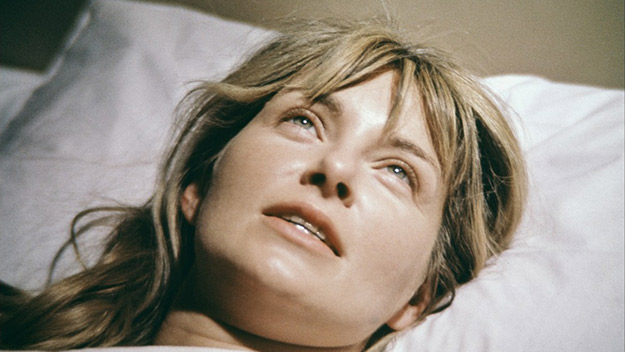
“Don’t, Rachel, don’t.” These whispered words waft across the soundtrack at a brief but crucial moment in the 1968 drama Rachel, Rachel, and they’re notable both because of the film’s otherwise sparing use of voiceover narration and for the specific context in which we hear them. It’s early in the film and Joanne Woodward’s title character—a single, small-town woman in her mid-thirties who, as evidenced in contemporary reviews, earlier generations would have uncharitably called a “spinster”—has been tossing and turning in bed. Movement under the sheets indicates that she’s bringing a hand down to the lower part of her body. She tries to convince herself that her desire for sexual pleasure is simply pragmatic: “It’s just so I can sleep.” In these few words, the film communicates that she thinks what she’s doing to her body is wrong, that she shouldn’t touch herself. “Don’t, Rachel, don’t.”
The scene fades out without revealing if she went through with it, but even the intimation of a main character’s masturbation—as a literal act, not an abstracted or metaphorical idea—was surely uncommon enough, even in late-’60s Hollywood, for this 30-second scene to register as a startling provocation. It’s a tiny passage that nevertheless stands in for so much: Rachel, Rachel, directed by Woodward’s husband, that paragon of masculinity Paul Newman, is an American studio movie that takes a woman’s sexual liberation as its subject matter, still a rare focus 50 years later. Made five years after the publication of The Feminine Mystique and two years after Betty Friedan cofounded the National Organization for Women, Newman’s film emerged into a mainstream culture in which ideas about women’s liberation were percolating. However, Jill Johnston’s Lesbian Nation was still five years away, and the sizable gap between how the film views the freedom of its evidently heterosexual heroine and that of her close friend, a lesbian fellow schoolteacher named Calla Mackie, played by Estelle Parsons, speaks volumes about not just the film’s in-between era but also how—and why—Hollywood would continue to relegate gay characters to subordinate roles for decades to come.
Rachel, Rachel was Newman’s unlikely feature debut after a 1962 short based on Chekhov’s On the Harmfulness of Tobacco. It had originated as a property sought out by Woodward, an adaptation of Manitoban novelist Margaret Laurence’s 1966 novel A Jest of God. Shot in Danbury, Connecticut, though taking place in the fictional town of Manawaka that was a recurring setting in Laurence’s novels, Rachel, Rachel is graced with the evocative sense of location that would become a trademark of American cinema in the coming decade, and anchored by a typically ruminative and inward performance by Woodward. Rachel Cameron is introduced as an introverted, tightly wound schoolmarm in buttoned-up blouses; she still lives with her guilt-tripping mother, sports an infantilized ponytail, and sleeps in a pink bedroom that clearly hasn’t changed since childhood. In a film that announces its own subjective approach early on, the virginal Rachel is constantly in some kind of reverie, flashing back to childhood traumas rooted in the funeral home where her father worked or having mildly erotic daydreams in which the flirty school principal runs his hand across her face. Walking down her rural town’s main street, she imagines everyone’s staring at her, a perception which is rendered through dated filter effects and higher shutter speed. She alternates between paralyzingly fearful and smirky-secretive, but she always remains trapped somewhere behind a long maintained facade. On the other hand, Calla is gregarious, a woman who appears to be aggressively comfortable in her own skin. She wears bright colors, chunky necklaces, and confidently oversized round glasses; her chalkboard reads “GROOVIE HOLIDAES” in big colorful block letters; and she proselytizes about living every day to the fullest, asking Rachel, “Don’t you want to open yourself up to life and loving experiences?” One of the first things we see Calla do is release her homeroom’s pet canary out the school window on the last day before summer break, as her students cheer.
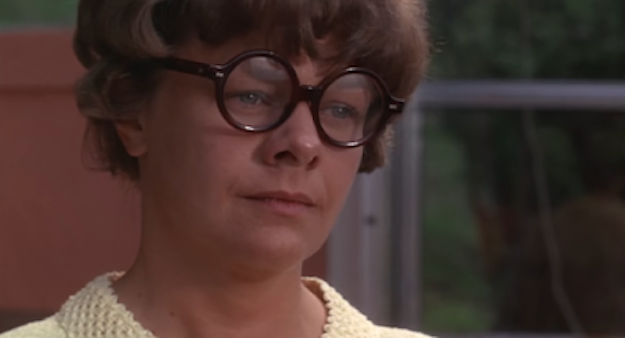
Purse-lipped Woodward and Parsons, with her wide jack-o’-lantern smile, make for a magnificent salty-sweet pair, the latter drawing out the former in their every scene together (the two were nominated for lead and supporting Oscars, respectively). As written and portrayed, Calla would seem to be everything Rachel is not: uninhibited, free to be herself. Yet perhaps there’s a double meaning to Calla suggesting that Rachel not always order vanilla ice cream? (“There are 30 other flavors, plus a flavor of the month,” after all.) And she does seem rather enamored of her dear friend, giving her the teasing nickname “Child” and buying her presents, including a little bonsai tree from the local flower show. Later, we see the full extent of her crush. Calla persuades a skeptical Rachel to accompany her to the Tabernacle of the Risen and Reborn, a gospel meeting that’s part evangelical revival, part flower-child love-in; there, Rachel is overcome by the emotional and especially the physical gauntlet of it all. After Rachel rushes out in panic, Calla comforts her, and under a tree by moonlight, begins to kiss her all over her face, initially in comfort, then with passion. The two then share a brief kiss full on the lips before Rachel recoils and runs away through the woods, the outpouring of confused emotions triggering a flashback to her prepubescent self running through a field of flowers. “I didn’t mean that, oh, God,” Calla calls out after her in evident terror—that she may lose her closest friend and that she may be revealed to the world for who she is.
In the novel, Laurence situates this transgression in a much more intimate setting: following the revival meeting, the two women are back in Calla’s flat. Laurence’s writing allows us access into Rachel’s feelings after the kiss: “I feel violated, unclean, as though I would strike her dead if I had the means. She pulls away then, too, and looks at me with a kind of bewilderment, a pleading apology, not saying a word. How ludicrous she looks, kneeling there, her wide face, her hands clasped anxiously.” Rachel’s interiority and Calla’s posture—her kneeling, her beseeching—make the encounter all the more desperate. Moving the setting to the open-air nighttime, Newman and screenwriter Stewart Stern avoid the possibility of genuine, tender eroticism, giving Rachel an easier escape hatch. Later, when Rachel loses her virginity to Nick (James Olson), a swaggering, hairy-chested former childhood acquaintance who has returned home to take care of his aging parents, the event also occurs outside at night, on a similarly secluded lawn surrounded by trees, as though it must be reclaimed as a heterosexual space. And despite the fact that Nick, shot at times with low angles that make him appear as though he’s baring down on the shorter Rachel, is far pushier sexually than Calla—“Just looking for a little action, thought you might be too,” is his own liberated pickup line—it’s the supportive, indefatigable Calla who ultimately must apologize for her bearing and being. “Oh, Rachel, I’ve been so miserable,” she tells her friend before scurrying off down her driveway in the middle of the night. “You don’t know what it’s like.”
From Sal Mineo’s Plato in Rebel Without a Cause (also written by Stewart Stern!) to Richard Jenkins’s supportive, lovelorn Giles in 2017’s insistently retro The Shape of Water, movies have long been decorated with tragic gay best friends, as well as sad stories of friendships riven in two by an ill-timed same-sex kiss (who can forget Philip Seymour Hoffman’s “I’m a fuckin’ idiot!” lament from Boogie Nights?). They are friends to the main characters for a very clear reason: by existing as secondary or subordinate they serve as foils to elucidate the plight of the protagonist. No matter how sympathetic they are portrayed—and Calla is ultimately a sympathetic character, played without condescension by Parsons, fresh off her Oscar win for 1967’s Bonnie and Clyde—they reflect a path not taken by the person we are meant to be truly invested in. In the case of Rachel, Rachel, a film about the gradual blossoming of a woman who had for years shut herself off to her physical desires and emotional needs, Calla, for all her outward signs of life and her social extroversion, is revealed as harboring aberrant feelings, and therefore feeling the wrong kind of love. Rachel may be lonely, but at least, according to the film’s logic, she’s not lesbian lonely, so there’s hope for her. Rachel gets out of town on a bus; Calla can only wave goodbye, stoically putting her glasses back on as she promises, “Not to worry, I’ll survive.”
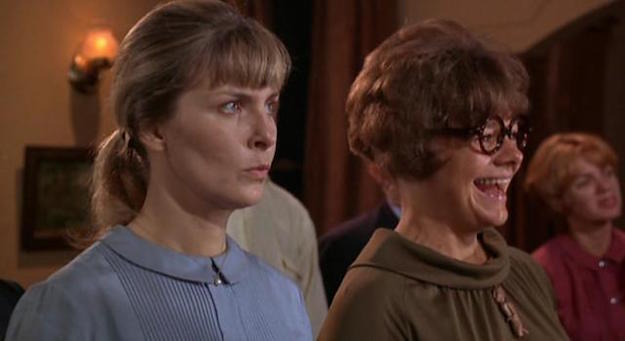
Outside of the U.S., there were films in 1968 that were less shy about investing lesbian characters with real life and libidos: in the U.K., Robert Aldrich’s The Killing of Sister George—a real hoot despite the X-rating warning away the straights—presented a sadomasochistic all-female love triangle with panache, its tendency to gawk at its characters considerably tempered by its devil-may-care approach to representation; in France, Claude Chabrol’s Les Biches allowed statuesque Stéphane Audran and gamine Jacqueline Sassard to play when Jean-Louis Trintignant wasn’t looking. But back home, it would still be a while before gay women were portrayed as anything other than vaguely butch schoolmarms. The irony of the sensitive, world-weary, and outwardly authentic Rachel, Rachel is that Calla would more likely be the one on the bus heading to places unknown, to communities that would love and accept her, where her vivacity and style would be put to good use. Rachel, stuck in a rut, would likely stay with her mother. But those are not the narratives we have long been told, the fictions that keep us all in our places.
Michael Koresky is the Director of Editorial and Creative Strategy at Film Society of Lincoln Center; the co-founder and co-editor of Reverse Shot; a frequent contributor to the Criterion Collection; and the author of the book Terence Davies, published by University of Illinois Press.



